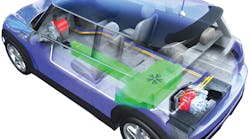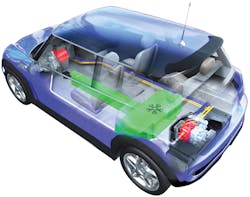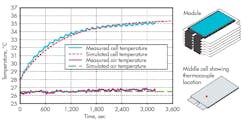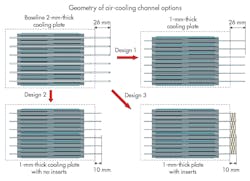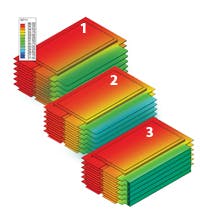Most hybrid vehicles today use Li-ion batteries, but heat is a major challenge. If cells in a battery pack become too hot, controls often protect them from damage by taking the car off battery power and switching it to the combustion engine. So, in a recent R&D project to convert a gasoline-powered car into a range-extender hybrid, the simulation team at AVL North America Inc., Plymouth, Mich., designed a low-cost cooling system for a battery pack consisting of 14 off-the-shelf modules.
To predict the battery’s working temperatures, AVL used Abaqus FEA software from Simulia, the 3Dexperience application from Dassault Systèmes, Waltham, Mass. The software mapped individual cell temperatures as well as heat concentrations throughout the pack. Engineers then fitted a prototype of the battery with temperature sensors anywhere the software predicated cold and hot spots. Finally, they correlated the FEA models to the prototype test results so they could design fan and circuit options for cooling at-risk sections of the battery.The Abaqus FEA software wasn’t specifically designed for battery simulation. But it can interface with user-written subroutines, so AVL engineers wrote some for Li-ion cells. Then they linked resulting values to the FEA model within Abaqus.
In fact, AVL now uses their custom subroutines to assess the electrical and thermal behavior of myriad Li-ion batteries — accounting for the effect of assorted Li-ion battery cell geometries, chemistries, and configurations, as well as the efficiency of various cooling methods. Before, AVL engineers just used the software to evaluate the structural integrity of Li-ion batteries and the thermal-mechanical behavior of traditional engine components.
When AVL assesses a battery-pack cooling design, engineers first make a few quick calculations to see how the pack will work. Then they add computational details about the cells, cooling fins, and circuits. Finally, they assess the whole battery in detailed 3D FEA, beginning with electrothermal analysis. The complexity of the inner-cell structures complicates this step: Depending on capacity, a cell can have up to 50 pairs of thin anode-cathode layers some 200-µm thick. But with 96 cells or more in a battery pack, it’s impractical to model cells in such detail. So AVL approximates with one to three equivalent cell layers per cell, and uses the equivalent composite properties to characterize battery behavior at the macro level.
“Also complicating matters is the search for accurate material data,” says AVL Technical Specialist Kim Yeow. “Cell manufacturers supply us with ballpark numbers, but we frequently end up searching literature or turning to other researchers for more-accurate figures. Oftentimes we end up with a range of material values.”
Despite that issue, AVL’s FEA models correlate well to actual lab measurements on the new 14-module batteries. Those measurements include battery quality under continuous discharge and continuous discharge-charge; liquid cooling and air-cooling; and direct and indirect cooling.
The next challenge for AVL is to simulate the battery assembly to see if cells make good physical contact with their cooling plates. “Initially we assumed good contact and heat transfer between the cooling plate and cells,” says Yeow, “but as the design matures we’ll simulate the assembly in Abaqus to find out where there might be gaps, how to minimize those gaps, and reevaluate how gaps in certain areas impact the cooling of battery cells.” In future projects, AVL designers also plan to more closely link electrothermal-battery models with corresponding structural and computational fluid-dynamics (CFD) models.
Resources:AVL North America Inc., 3DS
